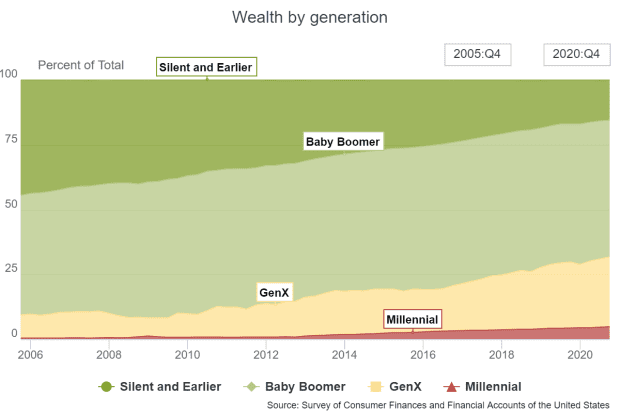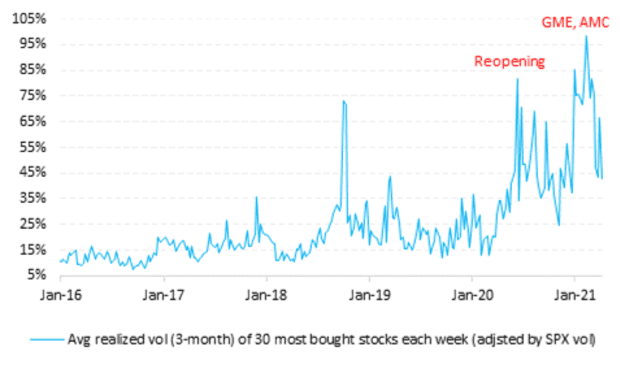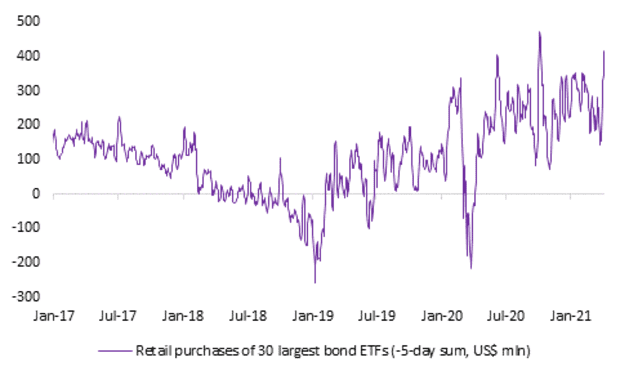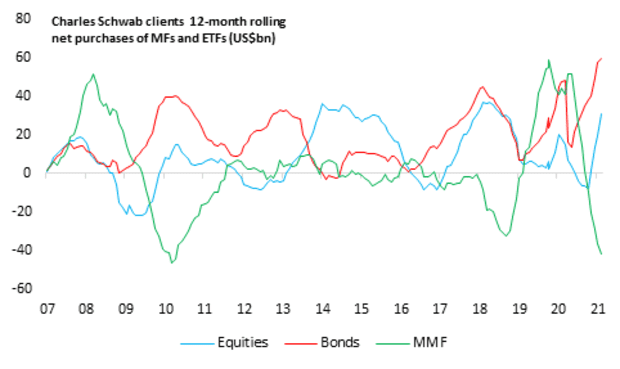This post was originally published on this site
The U.S. generation sitting on more wealth than any other — baby boomers — was all about bonds in 2020, but has just started to lead a retail charge back into equity markets.
That is according to independent research company Vanda Research, whose latest weekly data tracker showed individual investors returning to stocks sooner than expected after a bruising February. And at the head of the pack, were Americans born between 1946 and 1964, Vanda Research said.

VandaTrack
“Boomers were purchasing more bonds than equities throughout 2020, while millennials were buying stocks aggressively. The older investors started to be engaged again with the equity market only toward the end of last year (Nov. 2020) and their activity peaked this month. It is the first time that we see boomers leading the equity inflows,” said Giacomo Pierantoni, research analyst at Vanda, in emailed comments.
Since mid-February, individual investors underperformed the S&P 500
SPX,
by 11%, according to VandaTrack, which provides daily data on individual investors’ net purchases of U.S. stocks exchange-traded funds. The analysts expected a period of hibernation following that, but fresh data revealed average daily purchases of U.S. securities reaching $1.2 billion on April 6, then $1.5 billion on April 7, more than doubling a low of $772 million on March 26.
That inspired Vanda analysts to take a look at where the push into stocks might be coming from. “Some of the data suggests that wealthier individuals from the boomer generation may have been responsible for the ramp-up in purchases. The average investors’ age in platforms like Schwab or TD Ameritrade is close to 50 and they’re a lot more wealthy than millennials,” said Pierantoni and senior strategist Ben Onatibia in a note.
As of the fourth quarter of 2020, the boomer generation owned just over half of total U.S. household wealth, according to data from the Federal Reserve. That is a $64.72 trillion chunk, versus $5.89 trillion for millennials born after 1980, and $33.06 trillion for Generation X, born between 1965 and 1980.

The types of stocks being bought also offered clues, they said. “Their behavior is also a lot more conservative than younger investors’. Most of the stocks that made it to the top of our leader board this week are high-quality blue chips, while more speculative stocks like [videogames retailer GameStop]
GME,
or [movie-theater chain]
AMC,
have dropped out,” they said.
The below chart from VandaTrack shows average realized volatility of the 30 most bought stocks each week (relative to the S&P). The chart also “suggests that investors are being more conservative than in previous rallies,” they said.

VandaTrack
A continued strong rollout of COVID-19 vaccines in the U.S. and President Joe Biden’s $1.9 trillion infrastructure package may be encouraging investors into stocks, even if markets appear to be stalling at those record highs lately. A March study from Mizuho estimated 10% of recent stimulus checks could go into stocks and bitcoin.
Another reason Vanda suspects boomers are in the markets is due to unusually large flows into sovereign bond and credit exchange-traded funds.
Last week, it noted, individual investors pumped over $416 million into the 30 largest fixed income ETFs that trade in the U.S., the largest amount on record. The iShares iBoxx $ Investment Grade Corporate Bond ETF
LQD,
was the biggest contributor, with $128 million in purchases, Vanda said.

VandaTrack

Charles Schwab, Vanda
“While most Robinhooders tend to stay away from ‘boring’ fixed income products, boomers, who are closer to retirement, often prefer them to equities. Monthly data from Charles Schwab’s clients shows that inflows into bond ETFs and MFs [mutual funds] have been twice as large as equities,” said Pierantoni and Onatibia.


